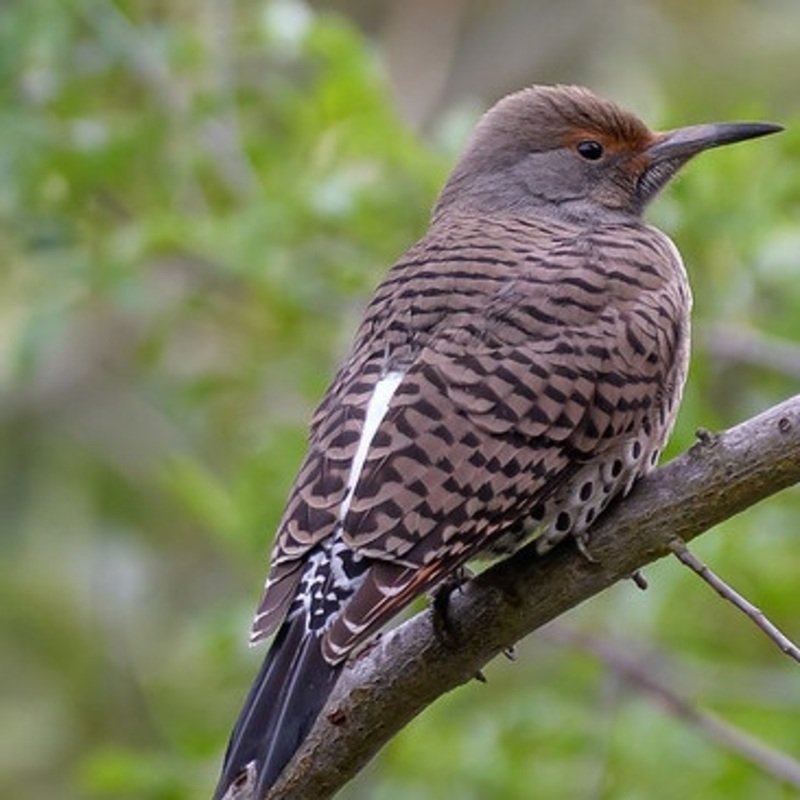Colaptes auratus or commonly known as the northern flicker also known as the common flicker is a medium-sized bird belonging to the woodpecker family that can be found in North America. Originally from North America, it is now found throughout the continent, as well as parts of Central America, Cuba, and the Cayman Islands. It is one of the few woodpecker species that migrate. They belong to the Picidae family.
Quick Overview: Colaptes Auratus – Northern Flicker
Body size: Around 12.75-14 in (32-36 cm) and a weight of 71 g (2.5 oz)
Main colors: Gray-Brown, White, Black, Yellow, Red
Range: Throughout the United States
Migratory Bird: Yes
Best time of the year to see in the U.S.: All Year (January – December)
Conservation Status: Least Concern
Northern flicker Description
The only woodpecker with a gray-brown back and a white rump. Black mustache and black crescent on the male’s breast. The male is a light tan with dark spotting underneath. Yellow-shafted Flicker has yellow underwings and tail, while the Red-shafted Flicker has reddish underwings.

Size
These birds have a length of 12.75-14 in (32-36 cm) and a weight of 71 g (2.5 oz). Their wings could range from 19-21 in (48-53 cm).
Feeding
Their main food is ants. They also eat grasshoppers, crickets, termites, wasps, aphids, beetles, caterpillars, and spiders. Weed seeds, acorns, and other nut kernels are also important foods. Fruit makes up more than half of their diet in the fall and winter.
Habitat
This woodpecker inhabits wooded areas with dead trees. Agri-land and residential areas also have them.
Behavior
Male flickers see females. To defend their mate or territory, male birds become aggressive toward females. They use aggressive displays like “bill directing” and “bill poking.” A flicker may peck at an opponent or point his bill at him. “Head swinging” is a more aggressive display where a flicker swings his head and body side to side against an opponent.
Colaptes auratus Scientific Classification
- Kingdom: Animalia
- Phylum: Chordata
- Subphylum: Chelicerata
- Class: Aves
- Order: Piciformes
- Family: Picidae
- Genus: Colaptes
- Species: Colaptes auratus
Other common names
It is known by more than 100 common names, including yellowhammer (not to be confused with the Eurasian yellowhammer), clape, gaffer woodpecker, harry-wicket, heigh-ho, wake-up, walk-up, wick-up, yarrup, and gawker bird. Numerous names for this species are derived from unsuccessful attempts to mimic some of its calls.
Best time of the year to see
In the United States, the best time of year to see these birds is all year round, regardless of the season. This refers to any month of the year between January and December
Distribution of the Northern flicker in the USA
This woodpecker ranges from Alaska to Quebec, then south across the United States. Northern Flickers migrate south and winter in northern Mexico. These woodpeckers can also be found in Grand Cayman, Cuba, and the highlands of Nicaragua.
The Northern flicker can be found in the following states in the United States – Alabama, Arizona, Arkansas, California, Colorado, Connecticut, Delaware, Florida, Georgia, Hawaii, Idaho, Illinois, Indiana, Iowa, Kansas, Kentucky, Louisiana, Maine, Maryland, Massachusetts, Michigan, Minnesota, Mississippi, Missouri, Montana, Nebraska, Nevada, New Hampshire, New Jersey, New Mexico, New York, North Carolina, North Dakota, Ohio, Oklahoma, Oregon, Pennsylvania, Rhode Island, South Carolina, South Dakota, Tennessee, Texas, Utah, Vermont, Virginia, Washington, West Virginia, Wisconsin and Wyoming.

